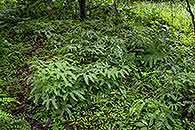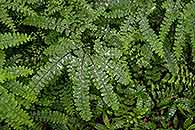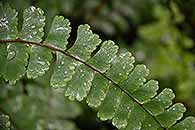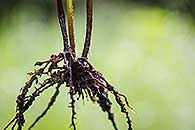Adiantum patens Willd. ssp. oatesii (Bak.) Schelpe
Synonyms |
Adiantum oatesii Baker |
|---|---|
Common name |
|
Description |
Rhizome creeping, short; rhizome scales 2 mm long, brown, slightly ciliate, tapering from the base to a sharp tip. Fronds monomorphic, tufted, herbaceous, arching. Stipe 10-40 cm long, thin, brown to black, glabrous. Lamina triangular in outline, 25 × 30 cm, pedately divided into up to 11 linear, pinnate pinnae, each terminating in a single apical pinnule; pinnules numerous, stalkletss short wiry, brown, 1-3 mm long, rhombic to broadly obcuneate in outline, upper and outer margins irregularly lobed, midrib forms the lower margin, 15-25 -(30) × 0.7-10 mm, hairless. Sori on pinnule lobes on the upper and outer margin of the undersurface, indusial flap circular to kidney-shaped, up to 2 mm in diameter, hairless. |
Notes | A. patens is pedately divided. It can be distinguished from A. hispidulum var. hispidulum which is sparsely set with hairs on the undersurface of the pinnae and has narrowly tapering pinnae segments. |
Derivation | patens: spreading, diverging from the axis at almost 90 degrees; referring to the fronds; oatesii:for Frank Oates (1840-1875), British naturalist and traveller who arrived in South Africa in 1873. |
Habitat | Slopes, rock-clefts, shady paths and banks, around boulder bases in forest and on streamsides in riverine forest. |
Distribution worldwide | See African distribution. |
Distribution in Africa |
Burundi, Cameroon, Dem. Republic of Congo, Ghana, Nigeria, Sudan and South Sudan, Tanzania , Uganda, Zambia, Zimbabwe. |
Growth form |
Terrestrial. |
Literature |
|




